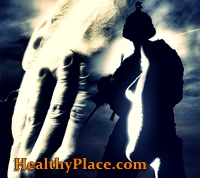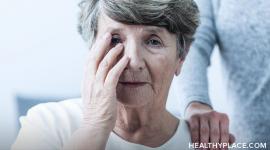Posttraumatic Stress Disorder (PTSD) Overview

Thorough overview of Posttraumatic Stress Disorder (PTSD). Description of PTSD- PTSD symptoms and causes, treatment for PTSD.
What is Posttraumatic Stress Disorder (PTSD)
It's been called shell shock, battle fatigue, accident neurosis, and post-rape syndrome. It has often been misunderstood or misdiagnosed, even though the disorder has very specific symptoms that form a definite psychological syndrome.
The disorder is posttraumatic stress disorder (PTSD) and it affects hundreds of thousands of people who have been exposed to violent events such as rape, domestic violence, child abuse, war, accidents, natural disasters, and political torture. Psychiatrists estimate that up to one to three percent of the population have clinically diagnosable PTSD. Still more show some symptoms of the disorder. While it was once thought to be a disorder of war veterans who had been involved in heavy combat, researchers now know that PTSD can result from many types of trauma, particularly those that include a threat to life. It afflicts both females and males.
In some cases the symptoms of PTSD disappear with time, while in others they persist for many years. PTSD often occurs with other psychiatric illnesses, such as depression.
Not all people who experience trauma require treatment; some recover with the help of family, friends, a pastor or rabbi. But many do need professional help to successfully recover from the psychological damage that can result from experiencing, witnessing or participating in an overwhelmingly traumatic event.
Although the understanding of posttraumatic stress disorder is based primarily on studies of trauma in adults, PTSD also occurs in children as well. It is known that traumatic occurrences--sexual or physical abuse,loss of parents, the disaster of war--often have a profound impact on the lives of children. In addition to PTSD symptoms, children may develop learning disabilities and problems with attention and memory. They may become anxious or clinging, and may also abuse themselves or others.
PTSD Symptoms
The symptoms of PTSD may initially seem to be part of a normal response to an overwhelming experience. Only if those symptoms persist beyond three months do we speak of them being part of a disorder. Sometimes the disorder surfaces months or even years later. Psychiatrists categorize PTSD's symptoms in three categories: intrusive symptoms, avoidant symptoms, and symptoms of hyperarousal.
Intrusive Symptoms
Often people suffering from PTSD have an episode where the traumatic event "intrudes" into their current life. This can happen in sudden, vivid memories that are accompanied by painful emotions. Sometimes the trauma is "re-experienced." This is called a flashback--a recollection that is so strong that the individual thinks he or she is actually experiencing the trauma again or seeing it unfold before his or her eyes. In traumatized children, this reliving of the trauma often occurs in the form of repetitive play.
At times, the re-experiencing occurs in nightmares. In young children, distressing dreams of the traumatic event may evolve into generalized nightmares of monsters, of rescuing others or of threats to self or others.
At times, the re-experience comes as a sudden, painful onslaught of emotions that seem to have no cause. These emotions are often of grief that brings tears, fear or anger. Individuals say these emotional experiences occur repeatedly, much like memories or dreams about the traumatic event.
Symptoms of Avoidance
Another set of symptoms involves what is called avoidance phenomena. This affects the person's relationships with others, because he or she often avoids close emotional ties with family, colleagues and friends. The person feels numb, has diminished emotions and can complete only routine, mechanical activities. When the symptoms of "re-experiencing" occur, people seem to spend their energies on suppressing the flood of emotions. Often, they are incapable of mustering the necessary energy to respond appropriately to their environment: people who suffer posttraumatic stress disorder frequently say they can't feel emotions, especially toward those to whom they are closest. As the avoidance continues, the person seems to be bored, cold or preoccupied. Family members often feel rebuffed by the person because he or she lacks affection and acts mechanically.
Emotional numbness and diminished interest in significant activities may be difficult concepts to explain to a therapist. This is especially true for children. For this reason, the reports of family members, friends, parents,teachers and other observers are particularly important.
The person with PTSD also avoids situations that are reminders of the traumatic event because the symptoms may worsen when a situation or activity occurs that reminds them of the original trauma. For example, aperson who survived a prisoner-of-war camp might overreact to seeing people wearing uniforms. Over time, people can become so fearful of particular situations that their daily lives are ruled by their attempts to avoid them.
Others--many war veterans, for example--avoid accepting responsibility for others because they think they failed in ensuring the safety of people who did not survive the trauma. Some people also feel guilty because they survived a disaster while others--particularly friends or family--did not. In combat veterans or with survivors of civilian disasters, this guilt may be worse if they witnessed or participated in behavior that was necessary to survival but unacceptable to society. Such guilt can deepen depression as the person begins to look on him or herself as unworthy, a failure, a person who violated his or her pre-disaster values. Children suffering from PTSD may show a marked change in orientation toward the future. A child may, for example, not expect to marry or have a career. Or he or she may exhibit "omen formation," the belief in an ability to predict future untoward events.
PTSD sufferers' inability to work out grief and anger over injury or loss during the traumatic event mean the trauma will continue to control their behavior without their being aware of it. Depression is a common product of this inability to resolve painful feelings.
Symptoms of Hyperarousal
PTSD can cause those who suffer with it to act as if they are threatened by the trauma that caused their illness. People with PTSD may become irritable. They may have trouble concentrating or remembering current information, and may develop insomnia. Because of their chronic hyperarousal, many people with PTSD have poor work records, trouble with their bosses and poor relationships with their family and friends.
The persistence of a biological alarm reaction is expressed in exaggerated startle reactions. War veterans may revert to their war behavior, diving for cover when they hear a car backfire or a string of firecrackers exploding.At times, those with PTSD suffer panic attacks, whose symptoms include extreme fear resembling that which they felt during the trauma. They may feel sweaty, have trouble breathing and may notice their heart rate increasing. They may feel dizzy or nauseated. Many traumatized children and adults may have physical symptoms, such as stomachaches and headaches, in addition to symptoms of increased arousal.
Other Associated Features
Many people with PTSD also develop depression and may at times abuse alcohol or other drugs as a "self-medication" to blunt their emotions and forget the trauma. A person with PTSD may also show poor control over his or her impulses and may be at risk for suicide.
Treatment for PTSD
Psychiatrists and other mental health professionals today have effective psychological and pharmacological treatments available for PTSD. These treatments can restore a sense of control and diminish the power of past events over current experience. The sooner people are treated, the more likely they are to recover from a traumatizing experience. Appropriate therapy can help with other chronic trauma-related disorders, too.
Psychiatrists help people with PTSD by helping them to accept that the trauma happened to them, without being overwhelmed by memories of the trauma and without arranging their lives to avoid being reminded of it.
It is important to re-establish a sense of safety and control in the PTSD sufferer's life. This helps him or her to feel strong and secure enough to confront the reality of what has happened. In people who have been badlytraumatized, the support and safety provided by loved ones is critical. Friends and family should resist the urge to tell the traumatized person to "snap out of it," instead allowing time and space for intense grief and mourning. Being able to talk about what happened and getting help with feelings of guilt, self-blame, and rage about the trauma usually is very effective in helping people put the event behind them. Psychiatrists know that loved ones can make a significant difference in the long-term outcome of the traumatized person by being active participants in creating a treatment plan--helping him or her to communicate and anticipating what he or she needs to restore a sense of equilibrium to his or her life. If treatment is to be effective it is important, too, that the traumatized person feel that he or she is a part of this planning process.
Sleeplessness and other symptoms of hyperarousal may interfere with recovery and increase preoccupation with the traumatizing experience. Psychiatrists have several medications--including benzodiazepines and the new class of serotonin re-uptake blockers--that can help people to sleep and to cope with their hyperarousal symptoms. These medications, as part of an integrated treatment plan, can help the traumatized person to avoid the development of long-term psychological problems.
In people whose trauma occurred years or even decades before, the professionals who treat them must pay close attention to the behaviors--often deeply entrenched--which the PTSD sufferer has evolved to cope with his or her symptoms. Many people whose trauma happened long ago have suffered in silence with PTSD's symptoms without ever having been able to talk about the trauma or their nightmares, hyperarousal, numbing, or irritability. During treatment, being able to talk about what has happened and making the connection between past trauma and current symptoms provides people with the increased sense of control they need to manage their current lives and have meaningful relationships.
Relationships are often a trouble spot for people with PTSD. They often resolve conflicts by withdrawing emotionally or even by becoming physically violent. Therapy can help PTSD sufferers to identify and avoid unhealthy relationships. This is vital to the healing process; only after the feeling of stability and safety is established can the process of uncovering the roots of the trauma begin.
To make progress in easing flashbacks and other painful thoughts and feelings, most PTSD sufferers need to confront what has happened to them, and by repeating this confrontation, learn to accept the trauma as part of their past. Psychiatrists and other therapists use several techniques to help with this process.
One important form of therapy for those who struggle with posttraumatic stress disorder is cognitive behavioral therapy. This is a form of treatment that focuses on correcting the PTSD sufferer's painful and intrusive patterns of behavior and thought by teaching him or her relaxation techniques, and examining (and challenging) his or her mental processes. A therapist using behavior therapy to treat a person with PTSD might, for example, help a patient who is provoked into panic attacks by loud street noises by setting a schedule that gradually exposes the patient to such noises in a controlled setting until he or she becomes "desensitized" and thus is no longer so prone to terror. Using other such techniques, patient and therapist explore the patient's environment to determine what might aggravate the PTSD symptoms and work to reduce sensitivity or to learn new coping skills.
Psychiatrists and other mental health professionals also treat cases of PTSD by using psychodynamic psychotherapy. Posttraumatic stress disorder results, in part, from the difference between the individual's personal values or view of the world and the reality that he or she witnessed or lived during the traumatic event. Psychodynamic psychotherapy, then, focuses on helping the individual examine personal values and how behavior and experience during the traumatic event violated them. The goal is resolution of the conscious and unconscious conflicts that were thus created. In addition, the individual works to build self-esteem and self-control, develops a good and reasonable sense of personal accountability and renews a sense of integrity and personal pride.
Whether PTSD sufferers are treated by therapists who use cognitive/behavioral treatment or psychodynamic treatment, traumatized people need to identify the triggers for their memories of trauma, as well as identifying those situations in their lives in which they feel out of control and the conditions that need to exist for them to feel safe. Therapists can help people with PTSD to construct ways of coping with the hyperarousal and painful flashbacks that come over them when they are around reminders of the trauma. The trusting relationship between patient and therapist is crucial in establishing this necessary feeling of safety. Medications can help in this process also.
Group therapy can be an important part of treatment for PTSD. Trauma often affects people's ability to form relationships--especially such traumas as rape or domestic violence. It can profoundly affect their basic assumption that the world is a safe and predictable place, leaving them feeling alienated and distrustful, or else anxiously clinging to those closest to them. Group therapy helps people with PTSD to regain trust and a sense of community, andto regain their ability to relate in healthy ways to other people in a controlled setting.
Most PTSD treatment is done on an outpatient basis. However, for people whose symptoms are making it impossible to function or for people who have developed additional symptoms as a result of their PTSD, inpatient treatment is sometimes necessary to create the vital atmosphere of safety in which they can examine their flashbacks, re-enactments of the trauma, and self-destructive behavior. Inpatient treatment is also important for PTSD sufferers who have developed alcohol or other drug problems as a result oftheir attempts to "self medicate." Occasionally too, inpatient treatment can be very useful in helping a PTSD patient to get past a particularly painful period of their therapy.
The recognition of PTSD as a major health problem in this country is quite recent. Over the past 15 years, research has produced a major explosion of knowledge about the ways people deal with trauma--what places them at risk for development of long-term problems, and what helps them to cope. Psychiatrists and other mental health professionals are working hard to disseminate this understanding, and an increasing number of mental health professionals are receiving specialized training to help them reach out to people with Posttraumatic Stress Disorder in their communities.
For comprehensive information on posttraumatic stress disorder (PTSD) and other anxiety disorders, visit the HealthyPlace.com Anxiety-Panic Community.
(c) Copyright 1988 American Psychiatric Association
Produced by the APA Joint Commission on Public Affairs and the Division of Public Affairs. This document contains the text of a pamphlet developed for educational purposes and does not necessarily reflect opinion or policy of the American Psychiatric Association.
Additional Resources
Burgess, Ann Wolbert. Rape: Victims of Crisis. Bowie, Maryland: Robert J. Brady, Co., 1984.
Cole, PM, Putnam, FW. "Effect of Incest on Self and Social Functioning: A Developmental Psychopathology Perspective." Journal of Consulting and Clinical Psychology, 60:174-184, 1992.
Eitinger, Leo, Krell, R, Rieck, M. The Psychological and Medical Effects of Concentration Camps and Related Persecutions on Survivors of the Holocaust. Vancouver: University of British Columbia Press, 1985.
Eth, S. and R.S. Pynoos. Posttraumatic Stress Disorder in Children. Washington, DC: American Psychiatric Press, Inc., 1985.
Herman, Judith L. Trauma and Recovery. New York: Basic Books, 1992.
Janoff, Bulman R. Shattered Assumptions. New York: Free Press, 1992.
Lindy, Jacob D. Vietnam: A Casebook. New York: Brunner/Mazel, 1987.
Kulka, RA, Schlenger, WE, Fairbank J, et al. Trauma and the Vietnam War Generation. New York: Brunner/Mazel, 1990.
Ochberg F., Ed. Posttraumatic Therapies. New York: Brunner/Mazel, 1989.
Raphael, B. When Disaster Strikes: How Individuals and Communities Cope with Catastrophe. New York: Basic Books, 1986.
Ursano, RJ, McCaughey, B, Fullerton, CS. Individual and Community Responses to Trauma and Disaster: the Structure of Human Chaos. Cambridge, England: The Cambridge University Press, 1993.
van der Kolk, B.A. Psychological Trauma. Washington, DC: American Psychiatric Press, Inc., 1987.
van der Kolk, B.A. "Group Therapy with Traumatic Stress Disorder," in Comprehensive Textbook of Group Psychotherapy, Kaplan, HI and Sadock, BJ, Eds. New York: Williams & Wilkins, 1993.
Other Resources
Anxiety Disorders Association of America, Inc.
(301) 831-8350
International Society for Traumatic Stress Studies
(708) 480-9080
National Center for Child Abuse and Neglect
(205) 534-6868
National Center for Posttraumatic Stress Disorder
(802) 296-5132
National Institute of Mental Health
(301) 443-2403
National Organization for Victim Assistance
(202) 232-6682
U.S. Veterans Administration-Readjustment Counseling Service
(202) 233-3317
APA Reference
Staff, H.
(2009, January 2). Posttraumatic Stress Disorder (PTSD) Overview, HealthyPlace. Retrieved
on 2026, January 22 from https://www.healthyplace.com/other-info/psychiatric-disorder-definitions/post-traumatic-stress-disorder-ptsd-overview


